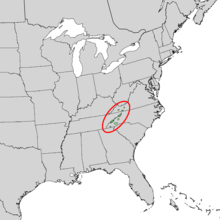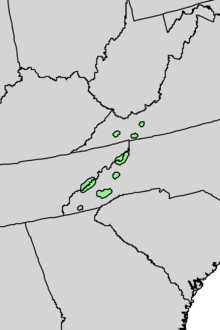Fraser fir
| Abies fraseri | |
|---|---|
 | |
| Foliage and cone | |
| Conservation status | |
| Scientific classification | |
| Kingdom: | Plantae |
| Division: | Pinophyta |
| Class: | Pinopsida |
| Order: | Pinales |
| Family: | Pinaceae |
| Genus: | Abies |
| Species: | A. fraseri |
| Binomial name | |
| Abies fraseri (Pursh) Poir., 1817 | |
 | |
| Natural range of Abies fraseri | |
 | |
| Synonyms[2] | |
| |
The Fraser fir, Abies fraseri, is a species of fir native to the Appalachian Mountains of the Southeastern United States.
Abies fraseri is closely related to Balsam fir (Abies balsamea), of which it has occasionally been treated as a subspecies (as A. balsamea subsp. fraseri (Pursh) E.Murray) or a variety (as A. balsamea var. fraseri (Pursh) Spach).[3][4][5][6]
Names
The species Abies fraseri is named after the Scottish botanist John Fraser (1750–1811), who made numerous botanical collections in the region.[4] It is sometimes misspelled "Frasier," "Frazer" or "Frazier."
The Fraser fir is quickly becoming the most premium species of the cut Christmas tree market. The Fraser has many desirable characteristics, especially its amazing needle retention; it's colloquially referred to as the "no shed" tree. The Fraser fir is also characterized by heavy density, with rich colors of platinum silver and deep bluish green.
The Fraser fir is in high demand on the export market. It has received greater exposure on the world market than any other tree. In 2009 Steve Jobs placed two fresh cut Frasers in the window of every Apple store in the world. The trees were sourced from North Pole Xmas Trees, a supplier from Nashua N.H.
In the past, it was also sometimes known as "she-balsam" because resin could be "milked" from its bark blisters,[7] in contrast to the "he balsam" (red spruce) which could not be milked. It has also occasionally been called balsam fir, inviting confusion with A. balsamea.[8]
Description

Abies fraseri is a small evergreen coniferous tree growing to between 30 and 50 feet (10–15 m) tall (rarely to 80 ft [25 m]) with a trunk 16 to 20 inches (40–50 cm) across (rarely up to 30 in, 75 cm). The crown is conical, with straight branches either horizontal or angled 40° upward from the trunk; it is dense when the tree is young, but becomes more open as it ages. The bark is thin and smooth, gray-brown with numerous resin blisters on young trees, becoming fissured and scaly with age. The foliage is strongly turpentine-scented.
The leaves are needle-like, arranged spirally on the twigs but twisted at the base to spread in two rows; they are 0.4 to 0.9 inches (10–23 mm) long and 79 to 87 mil (2–2.2 mm) broad, flat and flexible with a rounded or slightly notched tip, dark green to glaucous green above, often with a small patch of stomata near the tip, and with two silvery white stomatal bands on the underside.
The cones are erect, cylindric, 1.4 to 2.75 inches (3.5–7 cm) long (rarely to 3.2 in [8 cm]) and 1.0 to 1.2 inches (2.5–3 cm) broad (rarely as broad as 1.5 in [4 cm]) broad, dark purple, turning light brown when mature, with long reflexed green, yellow or pale purple bract scales, and often resinous. The cones disintegrate when mature at four to six months old to release the winged seeds.[3][4][5]
The Balsam fir variety Abies balsamea var. phanerolepis is regarded by some botanists as a natural hybrid between Balsam fir and Fraser fir, as Abies × phanerolepis (Fernald) Liu.[4]
Ecology
Reproduction and Growth
Fraser fir is monecious, meaning that both male and female flowers (strobili) occur on the same tree.[9] Flower buds usually open from mid-May to early June. Female flowers are borne mostly in the top few feet of the crown and on the outer ends of branches. Male flowers are borne below female flowers, but mostly in the top half of the crown. Seed production may begin when trees are 15 years old. Seeds germinate well on mineral soil, moss, peat, decaying stumps and logs, and even on litter that is sufficiently moist.[10]
Distribution

The Fraser fir, Abies fraseri, is restricted to the southeastern Appalachian Mountains in southwestern Virginia, western North Carolina and eastern Tennessee, where it occurs at high elevations, from 3,900 feet to the summit of Mount Mitchell, the highest point in the region at 6,683 feet (1,200 m up to 2,037 m). It lives in acidic moist but well-drained sandy loam, and is usually mixed with Picea rubens (red spruce). Other trees it grows with include Tsuga caroliniana (Carolina hemlock), Betula alleghaniensis (yellow birch), Betula papyrifera (paper birch), and Acer saccharum (sugar maple). The climate is cool and moist, with short, cool summers and cold winters with heavy snowfall.[3][4]
Pests
Abies fraseri is severely damaged by a non-native insect, the balsam woolly adelgid (Adelges piceae). The insect's introduction and spread led to a rapid decline in Fraser fir across its range, with over 80 percent of mature trees having been killed. The rapid regeneration of seedlings with lack of canopy has led to good regrowth of healthy young trees where the mature forests once stood. However, when these young trees get old enough for the bark to develop fissures, they may be attacked and killed by the adelgids as well.
For this reason, the future of the species is still uncertain, though the Mount Rogers (Virginia) population has largely evaded adelgid mortality. The decline of the Fraser fir in the southern Appalachians has contributed to loss of moss habitat which supports the spruce-fir moss spider.[6]
Cultivation and uses
Although not important as a source of timber, Fraser fir is widely used as a Christmas tree. Its mild fragrance, shape, strong limbs, and ability to retain its soft needles (which do not prick easily when hanging ornaments) for a long time when cut make it one of the best trees for this purpose.[11] Fraser fir has been used more times as the White House Christmas tree (the official Christmas tree of the President of the United States's White House) than any other tree.
It is grown in plantations in Scotland and sold by the thousands throughout the United Kingdom and Ireland. It is also cultivated from seedlings in several northern states in the USA and adjacent parts of Quebec province, especially for the Christmas tree trade.
The combination of form, needle retention, dark blue-green color, pleasant scent and excellent shipping characteristics has led to Fraser fir being a most popular Christmas tree species. Growing and harvesting this species for Christmas trees and boughs is a multimillion-dollar business in the southern Appalachians. North Carolina produces the majority of Fraser fir Christmas trees.[12] It requires from 7 to 10 years in the field to produce a 6–7 feet tree. In 2005, the North Carolina General Assembly passed legislation making the Fraser Fir the official Christmas tree of North Carolina.
See also
- Southern Appalachian spruce-fir forest
- Appalachian temperate rainforest
References
- ↑ Farjon, A. (2011). "Abies fraseri". IUCN Red List of Threatened Species. Version 3.1. International Union for Conservation of Nature. Retrieved 2013-11-10.
- ↑ "The Plant List: A Working List of All Plant Species". Retrieved 3 October 2014.
- ↑ 3.0 3.1 3.2 Farjon, A. (1990). Pinaceae. Drawings and Descriptions of the Genera. Koeltz Scientific Books ISBN 3-87429-298-3.
- ↑ 4.0 4.1 4.2 4.3 4.4 Liu, T.-S. (1971). A Monograph of the Genus Abies. National Taiwan University.
- ↑ 5.0 5.1 Flora of North America: Abies fraseri
- ↑ 6.0 6.1 Gymnosperm Database: Abies fraseri
- ↑ Frankenberg, D. (2000). Exploring North Carolina's Natural Areas: Parks, Nature Preserves, and Hiking Trails. Chapel Hill: University of North Carolina Press. ISBN 0-8078-4851-4. p343
- ↑ Sutton, M., & Sutton, A. (1985). Eastern forests (Audubon Society Nature Guides). New York: Knopf. ISBN 0-394-73126-3. p363
- ↑ Abies fraseri (Pursh) Poir, Silviculture Manual Volume 1, US Department of Agriculture Forest Service, Retrieved 20 October 2014
- ↑ Abies fraseri (Pursh) Poir. The National Christmas Tree Association, Retrieved 20 Oct 2014
- ↑ Hendrix, Steve, "A Christmas tree’s remarkable journey", The Washington Post, December 21, 2011.
- ↑ Fraser Fir North Carolina Department of Agriculture. Retrieved 24 November 2010
External links
| Wikimedia Commons has media related to Abies fraseri (Fraser fir). |
